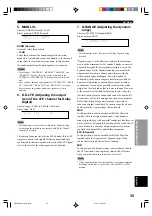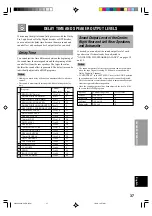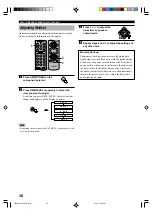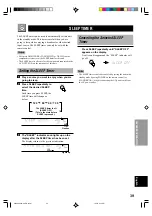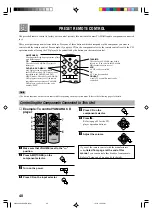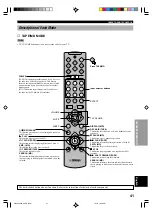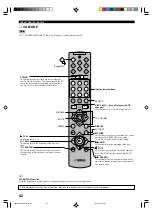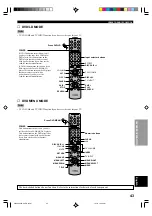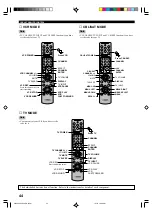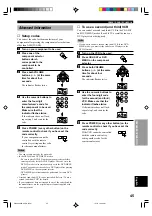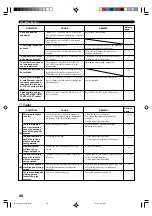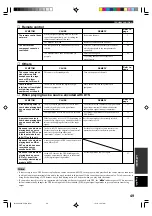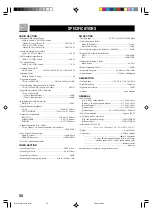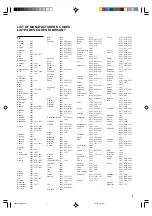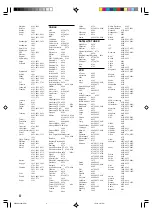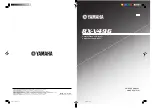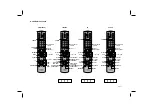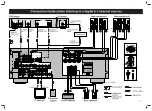
49
English
B
ASIC OPERA
TION
AD
V
ANCED OPERA
TION
APPENDIX
INTR
ODUCTION
PREP
ARA
TION
■
Remote control
This unit is in the standby mode.
Turn on the power of the unit.
SYMPTOM
CAUSE
REMEDY
SYMPTOM
CAUSE
REMEDY
Refer to
page
The remote control does
not work.
Direct sunlight or lighting (from an inverter
type of fluorescent lamp, etc.) is striking the
remote control sensor of this unit.
Reposition the unit.
The batteries are weak.
Replace all batteries with new ones.
The unit or other
component cannot be
controlled.
The component to be controlled has not been
selected.
Press one of the component selector buttons
which corresponds to the component to be
controlled.
The manufacturer’s code has not been set
properly.
Enter the code again.
Try setting another code for the same
manufacturer.
■
Others
SYMPTOM
CAUSE
REMEDY
Refer to
page
The sound is degraded
when listening with
headphones to a tape
deck or CD player
connected to this unit.
There is noise
interference from digital
or high-frequency
equipment, or the unit.
The unit is too close to the digital or high-
frequency equipment.
Move the unit further away from such
equipment.
■
When playing back a source encoded with DTS
Refer to
page
A loud hissing noise is
heard when playing back
a source encoded with
DTS.
The player which plays back the source is not
connected to a digital audio signal input
terminal of this unit.
The player must be connected to a digital audio
signal input terminal of this unit besides the
analog audio signal terminal connections.
The input mode is set to ANALOG on this unit.
Set a proper input mode to turn on the built-in
DTS decoder.
A percussive noise is
heard when playing back
a source encoded with
DTS.
If the input mode is set to AUTO, depending on
some sources, there may be a noise heard while
this unit is identifying the format of the input
signal.
Set the input mode of the currently selected
input source to DTS.
No sound is heard when
playing back a source
encoded with DTS, even
if the input mode is set
to AUTO on this unit.
The built-in DTS decoder does not function
because the player has a digital volume control
and it is set at a position other than
“maximum,” “neutral” or “ineffective.”
Set the player’s digital volume control at the
maximum, neutral or ineffective position.
No sound is heard when
playing back an MD or
DAT on which has been
recorded a source
encoded with DTS.
A source encoded with DTS cannot be recorded
on an MD or DAT.
No sound is heard when
playing back a source
(CD, etc.) even if the
currently selected input
mode is AUTO.
In the AUTO mode, the DTS-decoding mode
cannot be automatically changed to the normal
(PCM) digital signal input mode.
Set the input mode to AUTO again.
Notes
• It is necessary to use a DTS decoder to play back a source encoded with DTS, so the player which plays back the source must be connected
to a digital audio input terminal of this unit in the way described in this manual. If this connection is not made or only a D-to-A converter is
being used without using a DTS decoder, only a loud hissing noise will be heard when you play back the source.
• If you make a search (or skip, etc.) operation while playing back a source encoded with DTS, the “
t
” indicator goes off. This is because
this unit automatically changes the DTS-decoding mode to the standard (PCM) digital signal input mode to prevent a noise from being
output.
TROUBLESHOOTING
3
2
40
45
—
—
13
22
22
—
—
23
0110V49647-52_EN(UCA)
1/11/0, 10:37 AM
49
Содержание RX-V496
Страница 63: ......

